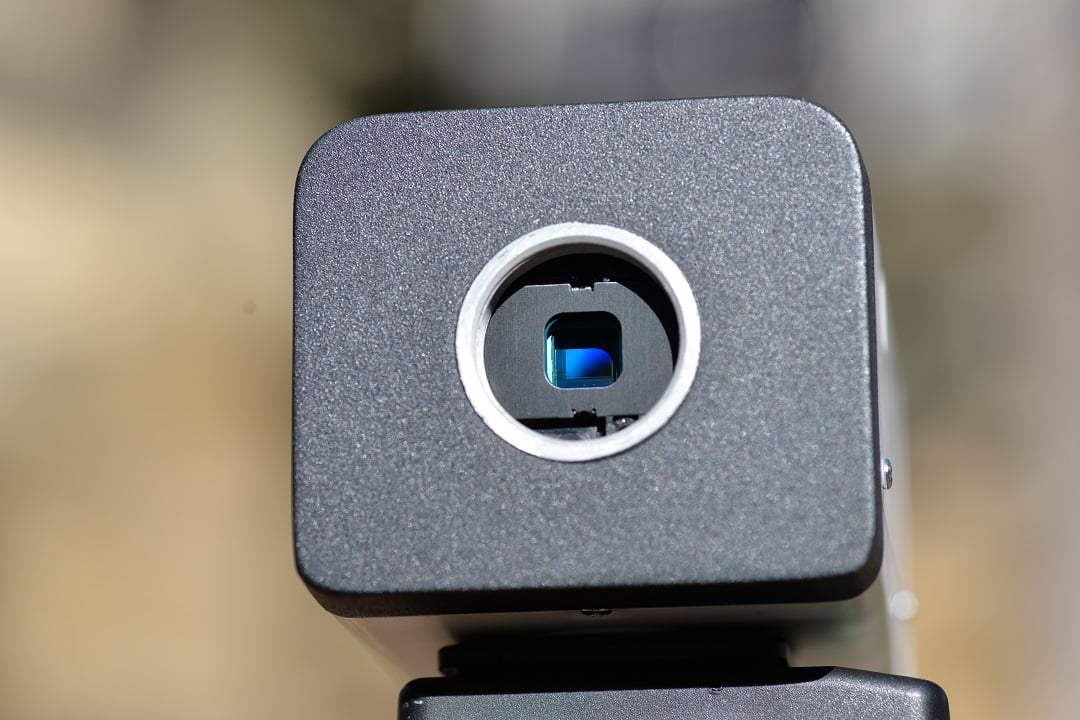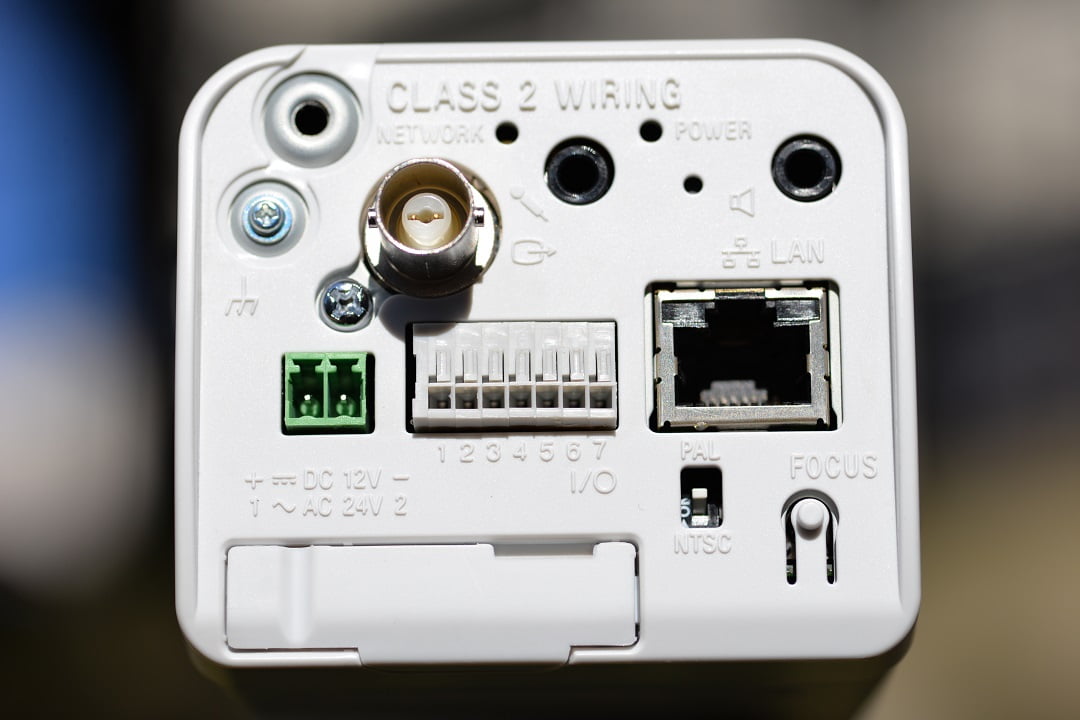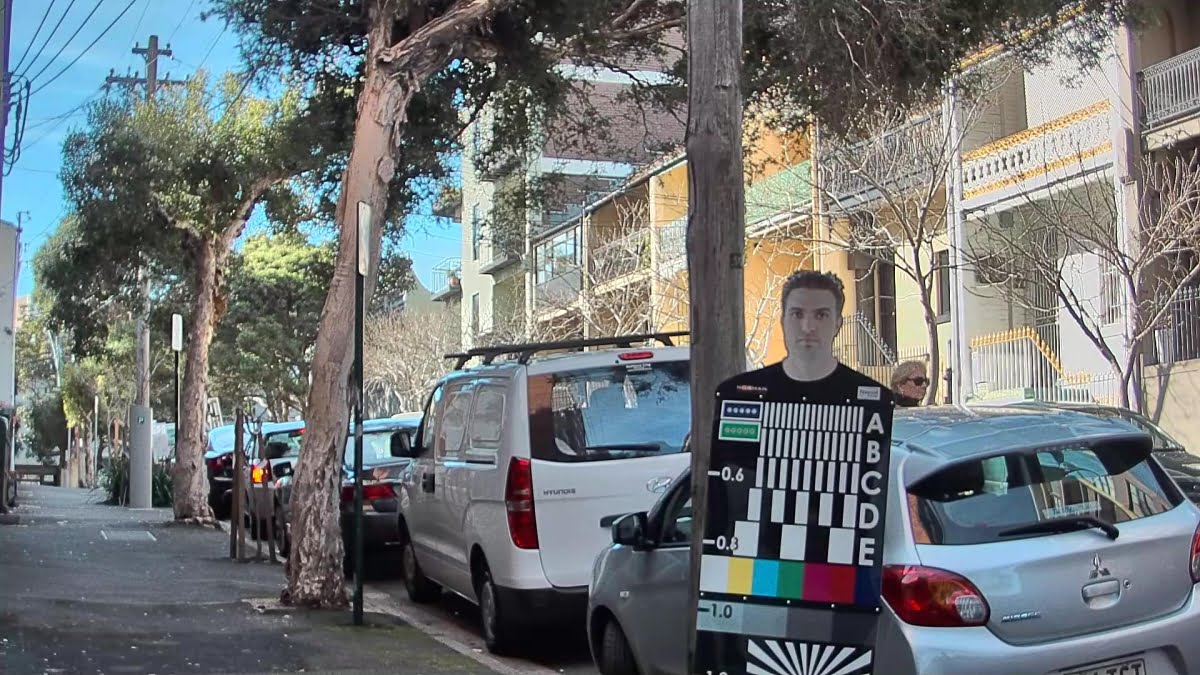Sony’s SNC-VB630 is a full body 1080p HD camera that combines strong WDR performance with good low light performance and very low latency. In our test the VB630 offers useful situational awareness in low light levels and positively eats backlight for breakfast.
SONY’S Gen6 SNC-VB630 features a 1/2.9-inch progressive scan Exmor CMOS sensor, with approximately 2.14MP. This day/night 1080p camera claims a minimum scene illumination of .1 of a lux (0.06 Lux 30IRE) at a shutter speed of 1/30th of a second in colour, or down to 0.05 lux (30 IRE)in monochrome. I don’t go this low but I think under 1 lux at the lens in monochrome is getting towards the minimum for useful situational awareness in street applications. That’s a good number for an unassisted camera. In our test we get down around l lux at the lens in our darkest target area.

Sitting behind the Exmor chip and handling much of this camera’s functionality is Sony’s IPELA Engine EX, an integrated signal processing system that combines Sony’s various signal processing and analytics technologies. These include an XDNR noise reduction processor to tidy up images in low light, View-DR which works to enhance light and dark areas of a scene, and the simultaneous DEPA Advanced Video analytics model. There’s also a Colour Adjustment module, and Encoding and Packetizing modules. The high frame rate mode – 60 fps in the model I’m testing – definitely delivers smoother, more natural movement.
A feature worth discussing is View-DR, which at 90 dB is designed to give clean images in tough backlit and high contrast conditions. It’s an interestingly modest WDR number that one – 90dB. But despite this apparently low number, the VB630 is an absolute bull in backlight – probably the best camera I’ve ever tested. I have no idea how or why, but it’s very strong.
DEPA Advanced Intelligent Video and Audio Analytics triggers alarms according to user-defined rules. In-camera analytics are enhanced by additional features such as face detection, left-object and removed-object detection, and intelligent motion detection. I don’t test these capabilities but they are there if you need them.

The camera I test has a 2.8-8mm lens, which gives a field of view between 114 degrees at the wide end and 40 degrees at the long end, while aperture moves from a very fast F1.2 wide to a still quick F1.95 with tele. With its 2.8-8mm f1.2 lens, the VB630 has an optical zoom of 2.9x and a digital zoom of 4x. The latter is a cropping tool at full frame, though it would definitely be useful if you were viewing an image stream on a VMS tile. I stay at full screen throughout this test.
In terms of setup via the camera browser there’s exposure control, exposure compensation, auto white balance, AGC, shutter speed, and iris control as well as image stabilisation and visibility enhancer. There’s a heap of other settings you can access through the browser. These include white balance which includes ATW, ATW-PRO, fluorescent, mercury, sodium vapour, metal halide, white LED, one push WB, and manual. I stay at auto though using sodium vapour might have been the best option.

There’s plenty more to play with here – the browser is a simple and effective as a commissioning tool and I use it to test the VB630 on SEN’s dedicated Dell 9020 server workstation. This setup has an Intel i7-4770 3.4GHz quad-core processor (8 threads per core), 8GB of RAM, and an AMD Radeon R7 250 graphics card with 2GB of RAM. Power and data are handled by a dedicated Netgear GS108P ProSafe 8-port Gigabit switch.
Test driving the SNC-VB630
AS soon as I power up the VB630 in the office I notice how good it is against backlight. It’s very strong and as the afternoon wears on my opinion is confirmed again and again. The VB630 is among the best full body cameras against backlight available on the market today. Generally speaking, all low end cameras, as well as some better cameras with monster WDR numbers, put so much effort into noise reduction their backlit image streams look like they were produced by Will Vinton.
With the VB630 there’s not the image smoothing you often see and this suggests there’s either not a huge amount of digital noise reduction going on under the hood, or what’s going on is very clever indeed. Something else you see with backlight management of many cameras is inconsistency of coverage between the dark and bright portions of the scene. Low cost cameras are the worst offenders but even good cameras can be strained by this. The VB630 seems oblivious. The transitions from light to dark are very seamless, the colours remain consistent. Looking through the office towards the glass backdoor, the image is great.


Typical hobbit hole barrel distortion internally in the first image – strength against backlight and rendering and transition of colour is exemplary.
My settings include a constant bitrate of 8000kbps, H264 Profile 1 set to high, WDR is on, visibility enhancement is set to the middle, backlight compensation is on, Auto gain is at maximum and shutter speed between 1/10000 and 1/25 of a second (it’s selectable between 1/10000s and 1/1s). I have auto white balance on, the XDNR is on high and all my image settings are at default. The camera also supports Variable Bit rate-VBR and maximum storage efficiency using VBR (capped with frame skip feature).
Just to see what happens, I drop noise reduction to low – this result is more noise in the form of pixel swim, so I go back to the high XDNR setting. I also start to play with image settings but the light is good enough and the camera is capable enough that there’s no great issue with colour rendition and I decide that I’m adjusting colour and hue just because it’s there. The colour rendition is very neutral and true.
Because the VB630 is a 1080p camera and the last camera I looked at was 4K, I am very aware of the difference in resolution and have to re-adjust my expectations. Discounting resolution, this is a quality image and later on I see this camera’s strength coming through as light levels plunge. It can do things UHD cameras can’t do unassisted in low light.
When I put the VB630 outside for the first time it’s about 1pm, the sun is in the top of the image – right smack in the image. With other cameras this would lead to blooming, muted colours or weird colour shifts but not with the Sony. It just soaks this up. Even wisps of cloud around the sun are clearly visible. There’s no flare or ghosting from the lens, though there’s some purple fringing on high contrast areas. Overall, with 85,000 lux at the lens I think this is the best image I’ve had out the back in terms of colour rendition. It’s true and it’s subtle in terms of discernment. There’s also very little latency – watching a helicopter fly across the skyline this is very noticeable.
 Classic barrel distortion, great colour rendition – and yes, that’s our local hydrogen fusion reactor above the puff of cloud top right…No lens flare, no ghosting, no sign of manic noise reduction.
Classic barrel distortion, great colour rendition – and yes, that’s our local hydrogen fusion reactor above the puff of cloud top right…No lens flare, no ghosting, no sign of manic noise reduction.
To begin with, I have the lens at its widest setting and focus is out towards infinity. There’s predictable barrel distortion out wide but the centre of the image is solid. Later on, I tighten the view so I’m towards the wide end of the middle of the 2.8-8mm f1.2 varifocal Mega Pixel lens fitted to the VB630. I stay at this focal length of about 4.5mm for the rest of the test until I take the camera out the front after dark and open it up.
The VB630 ships with a standard megapixel lens. It’s quick at f1.2, the front element of the lens is coated and in terms of performance, the optics work. It’s clearly built to a price, with a plastic mounting thread and a lightly built feel – most lenses I handle are the same way. Regardless, it holds up well to the beating I’m giving it and I find the zoom and focus adjustments to be smooth and progressive. It’s not the ooze of brass helicoids but the plastic internals have just enough resistance to create feel.
 Once again, the sun is present on the top edge of this image. There’s a little lateral chromatic abberation in the tower block on the right but you’d zoom to pixellation to find it. The depth of field apparent in this scene is all about the quality and subtlety of Sony’s colour rendering.
Once again, the sun is present on the top edge of this image. There’s a little lateral chromatic abberation in the tower block on the right but you’d zoom to pixellation to find it. The depth of field apparent in this scene is all about the quality and subtlety of Sony’s colour rendering.
Later in the afternoon there’s about 75,000 of bright winter sun in the year courtyard and the Sony stays tight. There’s still some purple fringing caused by chromatic aberration in the lens on the edge of a nearby office tower but at this 4.5mm mid focal length I’ve lost most the barrel distortion and have good coverage of the lane – it’s deep and wide enough for my purpose.
Something I keep noticing when looking at images from traffic in the lane is the lack of latency in this 1920 x 1080 image. When I check the frame rate and find it’s still set to 25ips I’m surprised – I was certain the camera was at 60ips with such low latency. Every time a vehicle moves through the field of view that lack of latency hits me again.
As the afternoon progresses, conditions pass through various challenging stages but throughout this period depth of field, colour rendition remain strong. Also noteworthy is lack of digital smoothing and absence of flare. The 1080p resolution of this sensor means you’re not getting the detail of UHD but in all other respects, this is a superior image. It will be interesting to see Sony’s UHD camera – combining such fundamentally capable performance with high resolution will be something else.

At about 4pm in the afternoon I start losing light from the weak winter sun. As usual, the image quality just keeps improving as light levels fall and digital noise reduction has less impact on detail in the image stream. Depth of field increases, colour tones look more balanced, fine detail in the distance sharpens – in fact the whole image looks best at 11 EV (about 5000 lux).
It’s interesting that despite only being 1080p, at the wide end of the range the VB630 makes the most of its resolution to give a very layered scene. I spend a lot of time looking the image trying to work out how the camera is managing this. Finally, I decide it’s due to the quality of the colour rendition. Even very subtle variations of colour are coming through and that adds detail and colour contrast deep into the scene. The unobtrusive nature of Sony’s View-DR must be contributing, too.

At only 4.30pm or so, the street lights come on, highlighting the watery nature of the late afternoon winter light. By 5.10pm we are down to 4.2 EV (about 40 lux) at the lens. The image is still good – there’s processing swim to be seen now but colour is still warm and true. There’s no noticeable blooming from the streetlights. Depth of field is still good. At about 5.20pm we are down to 1EV (5 lux) but we still have colour. There’s now blooming of light sources as the shutter slows and/or ISO winds up.

As light goes down to .5EV – 3.5 lux at the lens – the image gets a little smoky now but retains depth of field I have noise reduction on high still and the smooth-looking image is a result of this setting. We are still in colour. Situational awareness remains good, as does depth of field. When a car goes by there’s a little blooming but not too much and motion blur is well handled so shutter speed is not too slow.

At 5.30pm, just as I’m starting to wonder if I’ve accidentally set the VB630 is set to hold colour, the camera goes to black and white. Light at the lens is -1EV which is just over 1 lux. The image is being smoothed but with no absolutely no support from IR, there’s still full situational awareness out in the back lane. There’s now a wee ghost being created in the lens elements by the adjacent streetlight. From here on, light levels drop below the level my Sekonic can read (1.25 lux) at the lens. It’s not the best unassisted image I’ve had from a camera viewing this scene but we always retain good situational awareness of people and vehicles moving in the lane.
Next, I cart the tripod through the office. Out front the VB630 goes back into colour and stays there – the streetlight in front of the office has been replaced and it’s a little lighter out here than usual. I measure 7 lux at the lens, which is a fairly typical light level for public surveillance applications.


I have AWB on and light around the camera looks white but deeper into the scene and further from the lens, colours from the low pressure sodium lamps are tending towards orange. I could shift my light settings to sodium vapour to see if there’s an improvement but don’t. General situational awareness in this scene is very strong, despite the fact there’s no supporting illumination. Norman’s face at 7m from the lens is easily identifiable and there’s good contrast in the scene and across Norman’s target area.

At 18m Norman is out front of the Yaffa building with 14 lux on his face from a movement-activated lamp. We are not getting face recognition at this distance but we are getting his number plate and clear delineations of the colour and monochrome patterns from C onwards – A and B patterns have merged. At 30m we are not getting face recognition or the plate, but we are getting colour and delineation between D and E markings on Norman’s targets.
All these images are at the same mid-point focal length of 4.5mm, which I decide is the most effective focal length for this street scene. A wider view would liberate too many pixels. The longer focal length gives me better depth of field and there’s more than enough light to support this lens setting. Before I finish up, I take the lens out to wide angle and place Norman 4.5m from the lens. This is a good contrasty image, with clear face recognition and full coverage of the target area.
Going back to wide angle hands me back some of the aperture I lost at my mid-point focal length. Given the lens is f1.2 at wide and f1.95 at tele, I think I was at about f1.45 for most of the test. The faster aperture setting is noticeable in low light – no question about that – but I don’t think it impacted on my shots out the back in full sun. The VB630 was easily handling that scene with the aperture wide open.

 Out front the next day…the lens is at the long end in the first image Norman is at 7m, in the second he’s at 12m. I measure 5000 lux at Norman’s face and 70,000 lux across the street. Colour rendition is good, and with reflectance off opposite houses, WDR performance is good, too. This camera’s strength in colour variation increases depth of field and contrast, as does its backlight resistance.
Out front the next day…the lens is at the long end in the first image Norman is at 7m, in the second he’s at 12m. I measure 5000 lux at Norman’s face and 70,000 lux across the street. Colour rendition is good, and with reflectance off opposite houses, WDR performance is good, too. This camera’s strength in colour variation increases depth of field and contrast, as does its backlight resistance.
Sony’s SNC-VB630 is one of the best performers of the current crop of 1080p cameras. It offers unassisted situational awareness at under 1.25 lux at the lens and colour performance from about 3-4 lux. At 7 lux, which is a realistic ambient reading for street surveillance, the VB630 offers excellent situational awareness and colour rendition, as well as face recognition at 12-14m. License plates are discernible to about 18m, which is good performance, too.
While low light performance is solid at realistic shutter speeds, backlight performance is the standout feature of the VB630. WDR performance of this camera is the most accomplished of any camera we’ve tested and colour remained true even with two-thirds of the sun inside the frame. Other strong points of this camera are its low latency. With a higher grade lens, there’s no doubt the overall performance of Sony’s SNC-VB630 would be better still.♦
By John Adams
Fact File:
Features of the Sony SNC-VB630 tested include:
* 1920 x 1080 resolution at 60ips
* 2.8-8mm f1.2 varifocal lens
* DEPA Advanced IVA
* Face detection, tamper alarm
* Noise Reduction XDNR
* Privacy masking (20 masks)
* View-DR with WDR 90dB
* SD card edge storage
* Bitrate 64Kbps-32 Mbps
* Triple streaming
* G.711/G.726/AAC audio.









